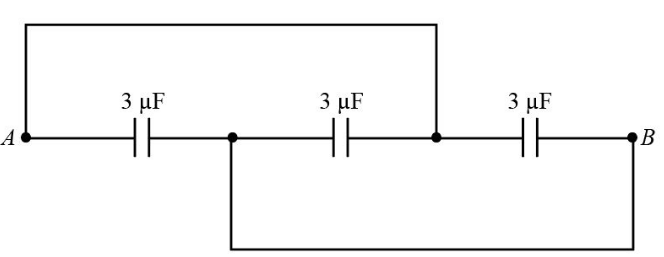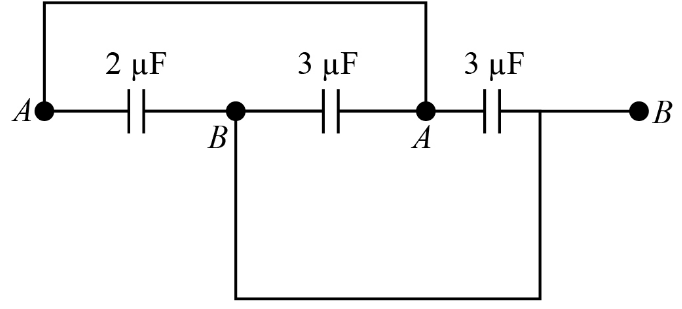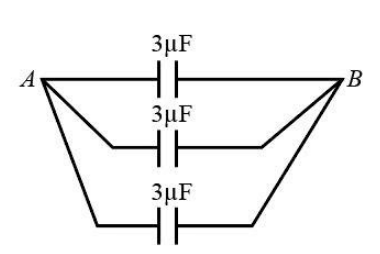
The equivalent capacitance between points ‘A’ and ‘B’ in figure will be
$
A. \,9\mu F\\
B. \,1\mu F\\
C. \,4.5F\\
D. \,6\mu F
$


Answer
550.2k+ views
Hint: In the question, we have to apply the concept of electric potential and the concept of a combination of capacitors. We have to convert the given figure to such a figure in which we can apply the formulas of capacitors in parallel or series combinations.
Complete step by step answer:
In the given figure we can see that the capacitance of all the capacitors are equal and is
$6\mu F$. If we look closely at the diagram provided, we can see there are two connections above and below the main circuit between A and B. Since in those connections, no load is attached and we neglect the potential drop occurring due to the wire, we can assume that no potential drop is occurring in both of the connections.
If no potential drop is occurring because of that connection, then the points joined by those connections will have equal electric potential and we can assume both of the points of each connection to be the same.The above explanation can be understood by the diagram given below,

Now that we have understood the potential at all the points, we can redraw the circuit to apply the formulas known to us about the parallel and series combination of the circuits.
In this question, we only have two points which have different potentials; therefore, first, we will plot those points and then we will check how many capacitors are there between those two points.
We can easily recognize that there are three capacitors between points A and B. One connection is at left, one is in the middle and one is on the right side. Therefore, we have 3 capacitors connected from points A to B, respectively.Hence, we will draw the resulting circuit:

By this circuit we can see that there are three capacitors in parallel to each other between the points A and B.
Now we can easily apply the formula of combination of capacitors in parallel circuit:
Hence, the equivalent capacitance between A and B Is:
$
{C_{eq}} = \,{C_1} + {C_2} + {C_3}\\
\Rightarrow{C_{eq}} = \,(3 + 3 + 3)\mu F\\
\therefore{C_{eq}}\, = 9\mu F
$
The equivalent capacitance between A and B is $9\mu F$ and the correct option is A.
Note: During the calculation of the potential of points, the potential of the connections has to be considered and only the points where no potential drop is occurring only those points are given the same points. And re-drawing the diagram has to be done considering the connections between all the points of different potential.
Complete step by step answer:
In the given figure we can see that the capacitance of all the capacitors are equal and is
$6\mu F$. If we look closely at the diagram provided, we can see there are two connections above and below the main circuit between A and B. Since in those connections, no load is attached and we neglect the potential drop occurring due to the wire, we can assume that no potential drop is occurring in both of the connections.
If no potential drop is occurring because of that connection, then the points joined by those connections will have equal electric potential and we can assume both of the points of each connection to be the same.The above explanation can be understood by the diagram given below,

Now that we have understood the potential at all the points, we can redraw the circuit to apply the formulas known to us about the parallel and series combination of the circuits.
In this question, we only have two points which have different potentials; therefore, first, we will plot those points and then we will check how many capacitors are there between those two points.
We can easily recognize that there are three capacitors between points A and B. One connection is at left, one is in the middle and one is on the right side. Therefore, we have 3 capacitors connected from points A to B, respectively.Hence, we will draw the resulting circuit:

By this circuit we can see that there are three capacitors in parallel to each other between the points A and B.
Now we can easily apply the formula of combination of capacitors in parallel circuit:
Hence, the equivalent capacitance between A and B Is:
$
{C_{eq}} = \,{C_1} + {C_2} + {C_3}\\
\Rightarrow{C_{eq}} = \,(3 + 3 + 3)\mu F\\
\therefore{C_{eq}}\, = 9\mu F
$
The equivalent capacitance between A and B is $9\mu F$ and the correct option is A.
Note: During the calculation of the potential of points, the potential of the connections has to be considered and only the points where no potential drop is occurring only those points are given the same points. And re-drawing the diagram has to be done considering the connections between all the points of different potential.
Recently Updated Pages
Master Class 12 Business Studies: Engaging Questions & Answers for Success

Master Class 12 Economics: Engaging Questions & Answers for Success

Master Class 12 English: Engaging Questions & Answers for Success

Master Class 12 Maths: Engaging Questions & Answers for Success

Master Class 12 Social Science: Engaging Questions & Answers for Success

Master Class 12 Chemistry: Engaging Questions & Answers for Success

Trending doubts
December 10th of 1948 is an important day in the history class 12 sst CBSE

Prove that a parallelogram circumscribing a circle-class-12-maths-CBSE

Dihybrid cross is made between RRYY yellow round seed class 12 biology CBSE

The correct structure of ethylenediaminetetraacetic class 12 chemistry CBSE

What is the Full Form of PVC, PET, HDPE, LDPE, PP and PS ?

The first microscope was invented by A Leeuwenhoek class 12 biology CBSE




